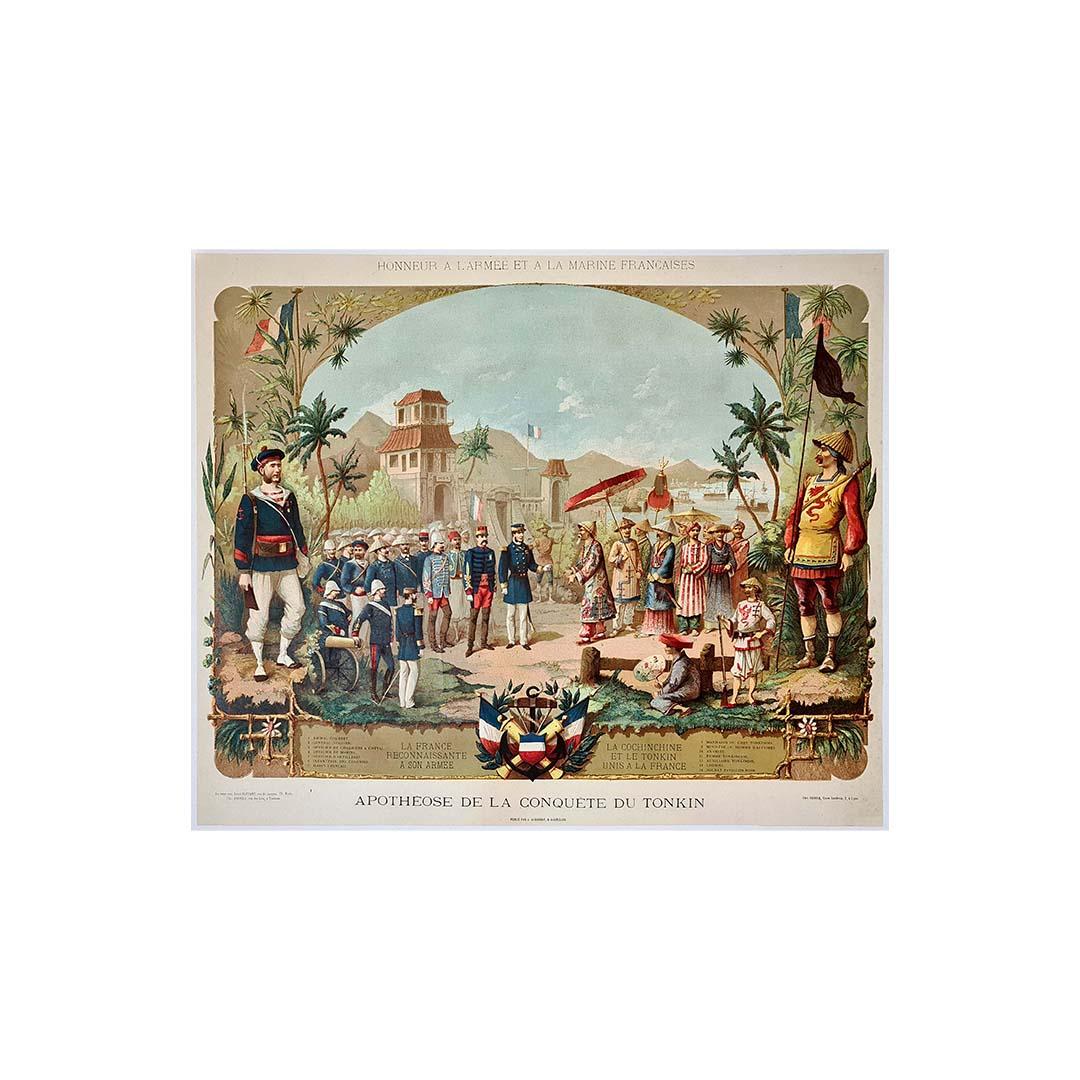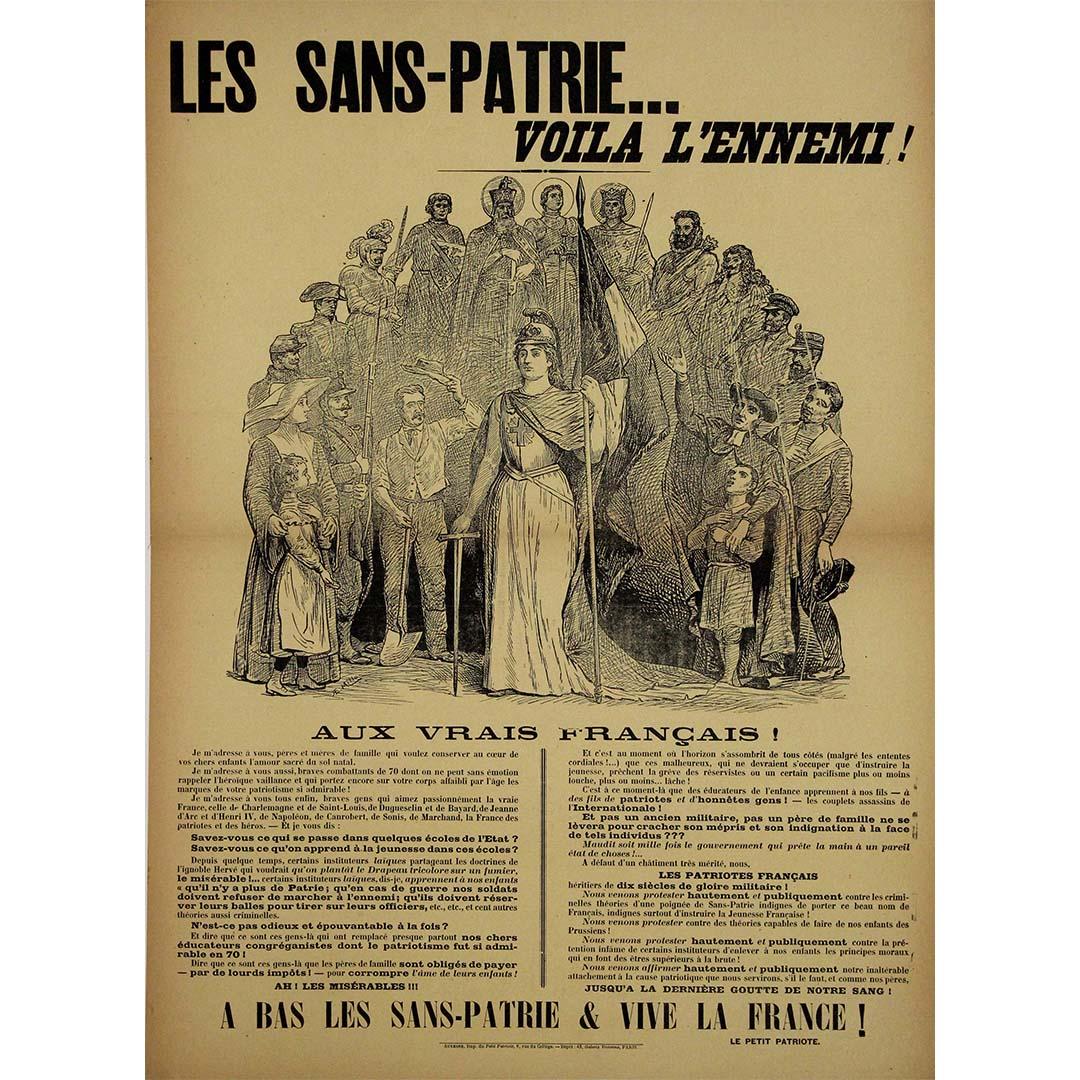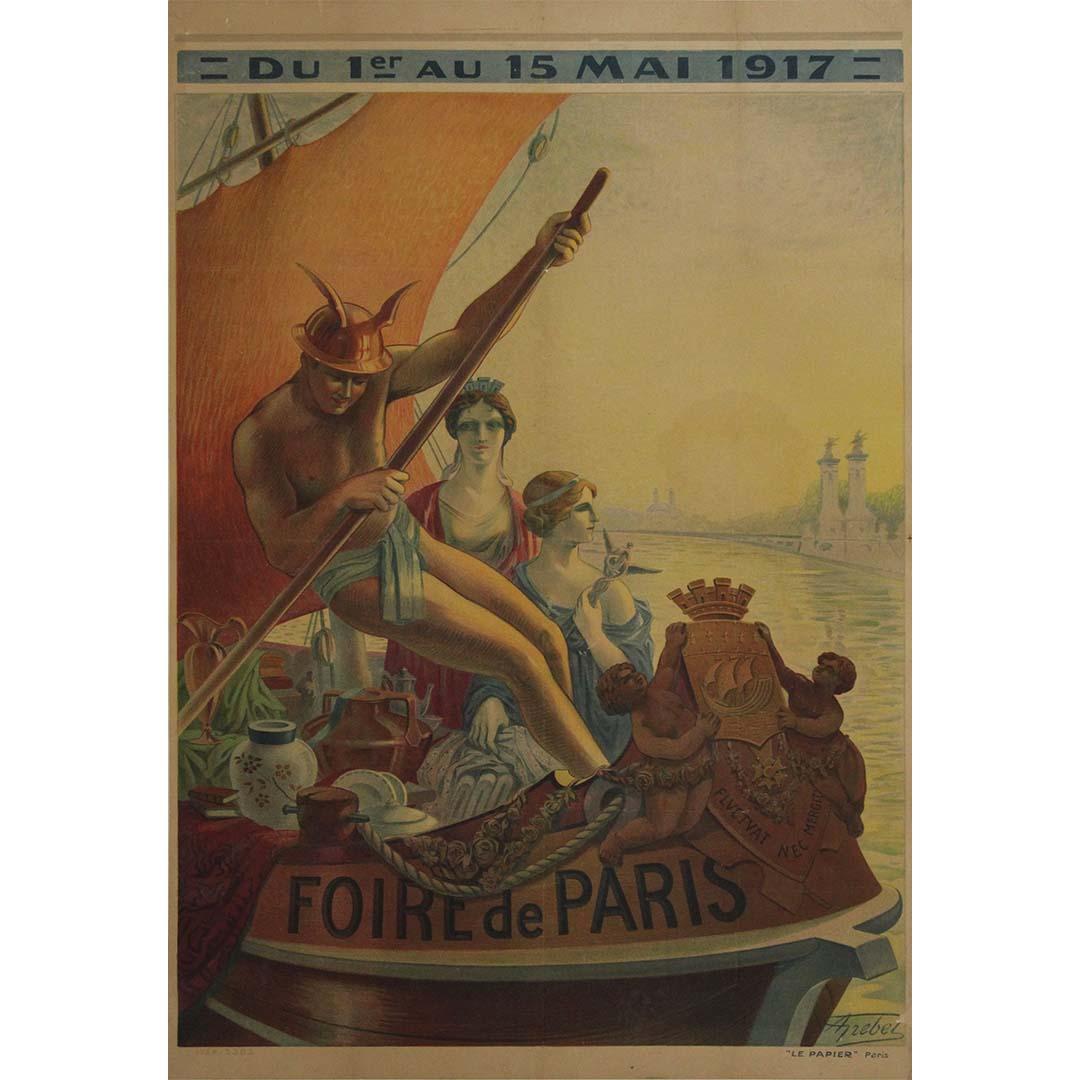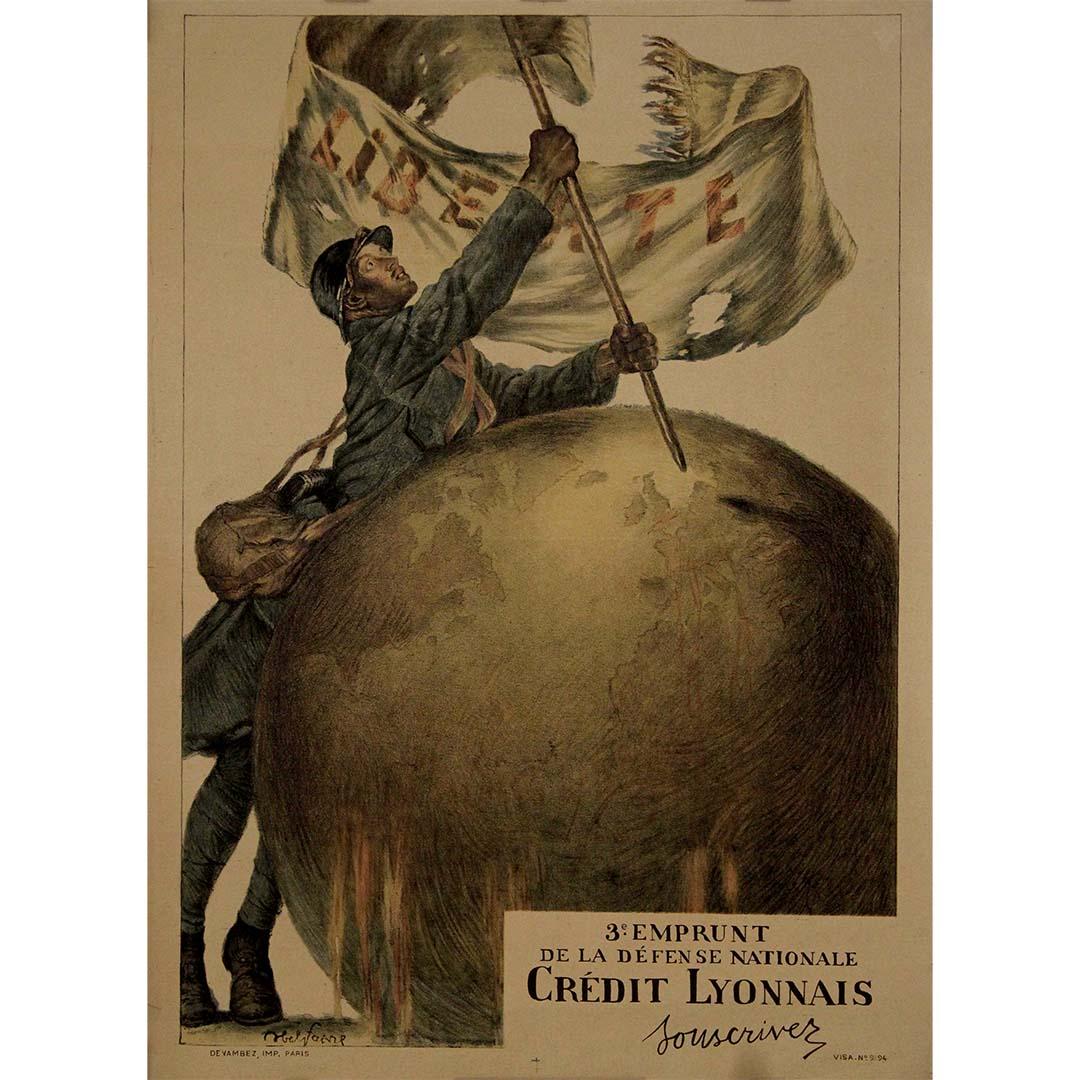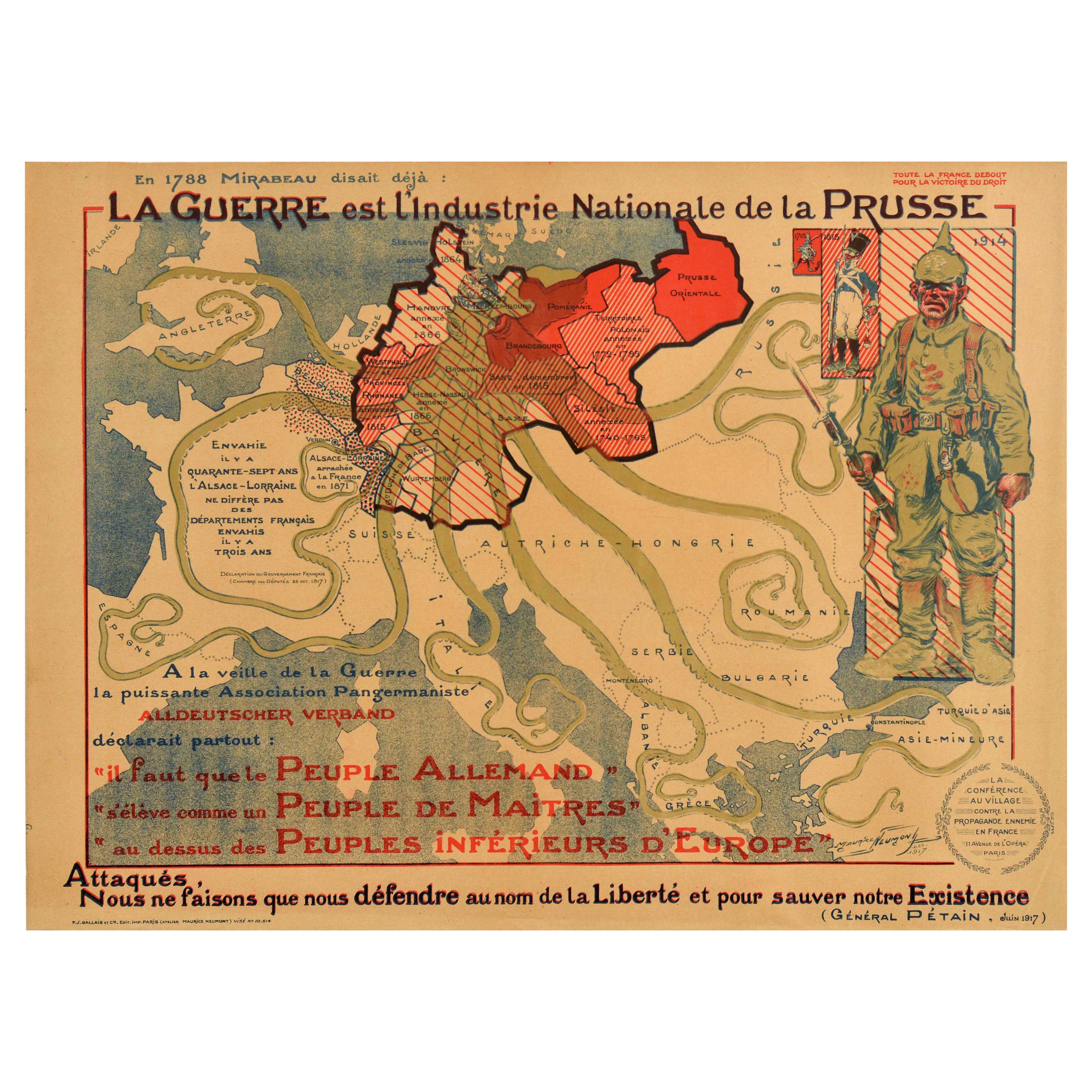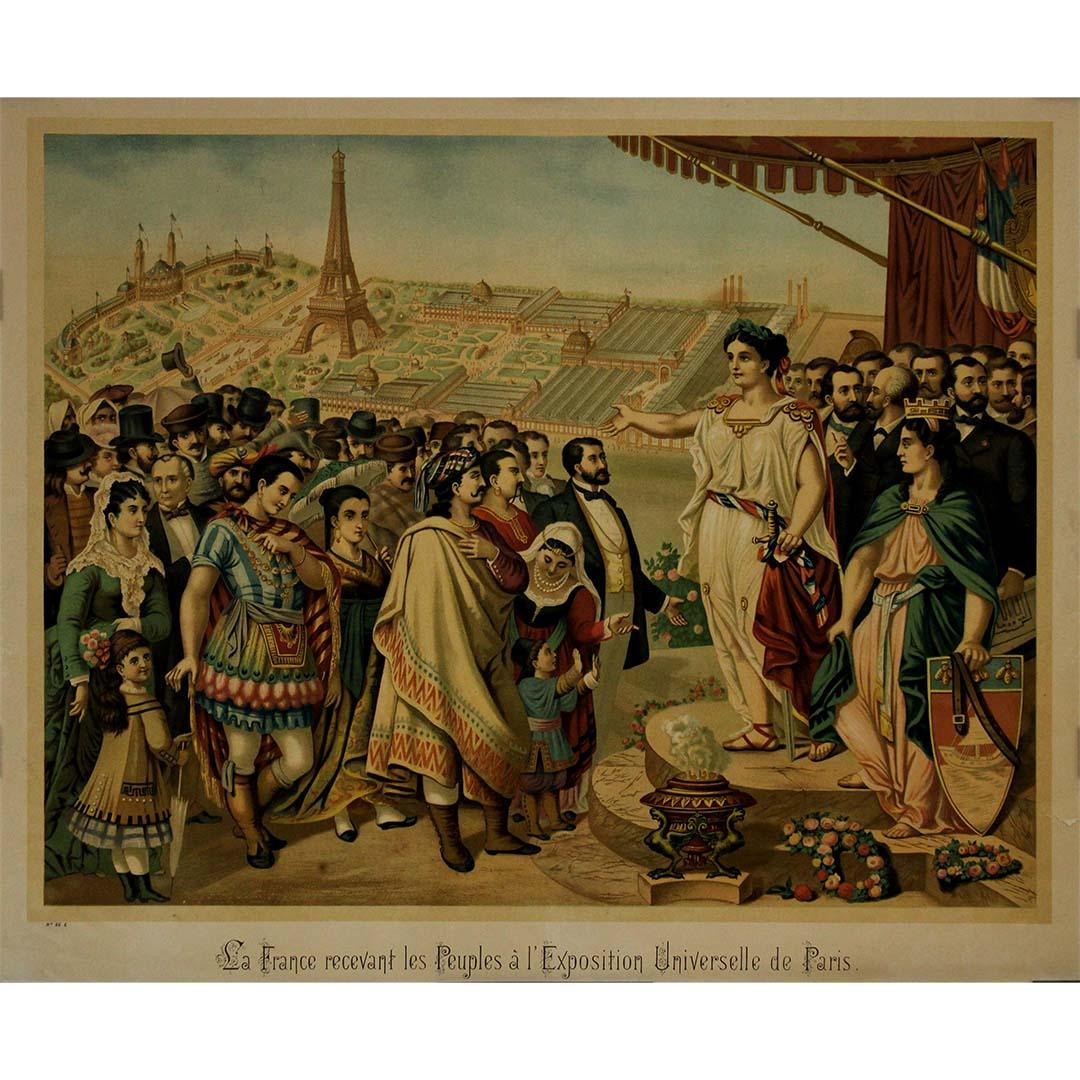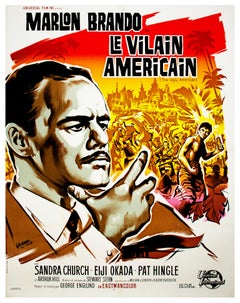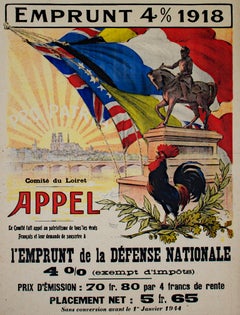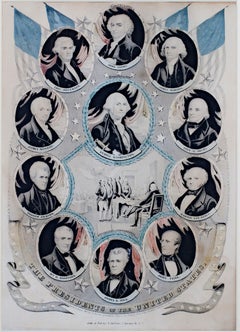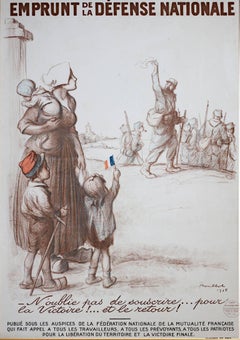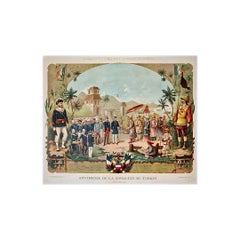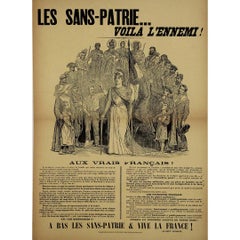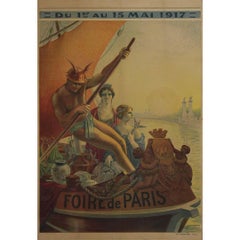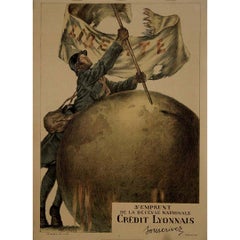Items Similar to Early 20th century color lithograph poster figures globe flags sun moon text
Want more images or videos?
Request additional images or videos from the seller
1 of 9
UnknownEarly 20th century color lithograph poster figures globe flags sun moon text1900
1900
$2,430
£1,885.66
€2,129.03
CA$3,477.10
A$3,794.15
CHF 1,962.97
MX$45,389.49
NOK 24,797.07
SEK 23,284.06
DKK 15,900.09
About the Item
"La Conquéte Du Pôle (The COnquest of the Pole)" is an original lithograph poster by an unknown artist published by the Club of America. It depicts personifications of major world powers racing to be the first to place their country's flag on the North Pole.
13 3/4" x 17 1/4" art
25 1/8' x 28 7/8" frame
- Creation Year:1900
- Dimensions:Height: 25.125 in (63.82 cm)Width: 28.875 in (73.35 cm)
- Medium:
- Period:
- Condition:
- Gallery Location:Milwaukee, WI
- Reference Number:Seller: 10033g1stDibs: LU60532913091
About the Seller
4.9
Gold Seller
Premium sellers maintaining a 4.3+ rating and 24-hour response times
Established in 1966
1stDibs seller since 2017
452 sales on 1stDibs
Typical response time: 1 hour
- ShippingRetrieving quote...Shipping from: Milwaukee, WI
- Return Policy
More From This Seller
View All20th century color lithograph film poster cinematic figures portrait text
Located in Milwaukee, WI
"Brando, Le Vilain Americain" is an original lithograph poster designed by "Ghirardi" for the 1963 film "The Ugly American."
62 1/4" x 47 ...
Category
1960s Other Art Style Figurative Prints
Materials
Lithograph
"Emprunt 4% 1918 - Appel, " Original Lithograph Poster by A. Malassinet
Located in Milwaukee, WI
"Emprunt 4% 1918 - Appel" is an original lithograph poster by A. Malassinet. This poster advertised a fund for the national defense during World War I. The following are two statemen...
Category
1910s Modern Landscape Prints
Materials
Lithograph
19th century color lithograph portraits patriotic American stars flags
By Nathaniel Currier
Located in Milwaukee, WI
"The Presidents of the U.S." is an original hand-colored lithograph by Nathaniel Currier. It features the first eleven presidents of the United States.
14" x 10" art
23" x 19 1/8" frame
Nathaniel Currier was born March 27, 1813 to Nathaniel and Hannah Currier in Roxbury, Massachusetts. At the age of fifteen he was apprenticed to William S. and John Pendleton of Boston who had set up the first lithographic establishment in America. His apprenticeship served him well as he went on to be the largest publisher of lithographs. Mr. Maurer described Nat Currier as being very gentlemanly and liberal. As is evident to the success of the firm of Currier & Ives he was very devoted to his business.
Nat Currier had many friends including Horace Greely and P.T. Barnum. He was well known for his sense of humor and Harry T. Peters tells one story about P. T. Barnum. "Currier had heard that one day his friend, the great showman, had rushed into the barber shop of the old Park Hotel, at Beekman and Nassau Streets, to get a shave. Barnum had hurried up to Tom Higginson, the barber, and said, 'Tom, I'm in a hurry.' 'Sorry for it,' said Tom, 'but it's that gentleman's turn next.' 'That gentleman' was an unshaven irshman waiting for a ten-cent shave. Barnum turned to him and said, 'My friend, if you will let me have your turn, I'll pay for what you have done.' The gentleman consented, and, as Barnum found out later, had a full job done - absolutely everything the house had. The check was for a dollar and sixty cents. When Currier heard this story he found the very Irishman and had him pose. The result was the famous cartoon, "The Man that Gave Barnum 'His Turn.'"
Nathaniel was married twice; his first wife was Miss Eliza West of Boston. He had one son with Eliza, Edward West Currier. In 1847 he married Miss Laura Ormsbee of Vermont. Laura and Nathaniel are memorialized in the famous N. Currier lithograph The Road Winter...
Category
1840s Academic Portrait Prints
Materials
Lithograph
20th century color lithograph poster military wartime figurative print French
By Francisque Poulbot
Located in Milwaukee, WI
"Emprunt de la Defense Nationale" is an original lithograph poster by Francisque Poulbot. It depicts a mother with three young children saying goodbye to her husband as he leaves for war. This was an advertisement for French people to donate to the war effort during the first world war.
43 1/2" x 30 1/4" art
48" x 34 1/2" frame
Emprunt de la Défense Nationale [National Defence Loan]
WW1 French...
Category
1910s Modern Figurative Prints
Materials
Lithograph
late 19th century color lithograph poster military figure drummer text
By Jules Chéret
Located in Milwaukee, WI
"Rappel" is an original lithograph poster designed by Jules Cheret. This poster depicts a young man drumming. There is a small stain in the upper left corner. This poster was publish...
Category
1890s Figurative Prints
Materials
Lithograph
19th century color lithograph portraits ship seascape patriotic flags military
By Nathaniel Currier
Located in Milwaukee, WI
The present hand-colored lithograph is an excellent example of patriotic mid-nineteenth century American imagery. The print shows the battle and several of the major figures involved in the Battle of Lake Erie: At the center is a view of several frigates on the lake, embroiled in conflict. Above the battle is the quotation: "We have met the enemy and they are ours." Surrounding are laurel-lined roundels with portraits of Oliver Hazard Perry (1785-1819), Stephen Dicateur (1779-1820), Johnston Blakeley (1871-1814), William Bainbridge (1774-1833), David Porter (1780-1843), and James Lawrence (1781-1813) - all of these framed by American flags, banners and cannons. This print shows that the Battle of Lake Erie, part of the War of 1812, still held resonance for American audiences several decades later and was part of the larger narrative of the founding of the country.
9.5 x 13.5 inches, artwork
20 x 23.38 inches, frame
Entitled in the image
Signed in the stone, lower left "Lith. and Pub. by N. Currier"
Inscribed lower right "2 Spruce N.Y." and "No. 1"
Copyrighted lower center "Entered according to Act of Congress in the year 1846 by N. Currier in the Clerk's office of the Southern District of N.Y."
Framed to conservation standards using 100 percent rag matting and housed in a gold gilded moulding.
Nathaniel Currier was a tall introspective man with a melancholy nature. He could captivate people with his piercing stare or charm them with his sparkling blue eyes. Nathaniel was born in Roxbury, Massachusetts on March 27th, 1813, the second of four children. His parents, Nathaniel and Hannah Currier, were distant cousins who lived a humble yet spartan life. When Nathaniel was eight years old, tragedy struck. Nathaniel’s father unexpectedly passed away leaving Nathaniel and his eleven-year-old brother Lorenzo to provide for the family. In addition to their mother, Nathaniel and Lorenzo had to care for six-year-old sister Elizabeth and two-year-old brother Charles. Nathaniel worked a series of odd jobs to support the family, and at fifteen, he started what would become a life-long career when he apprenticed in the Boston lithography shop of William and John Pendleton.
A Bavarian gentleman named Alois Senefelder invented lithography just 30 years prior to young Nat Currier’s apprenticeship. While under the employ of the brothers Pendleton, Nat was taught the art of lithography by the firm’s chief printer, a French national named Dubois, who brought the lithography trade to America.
Lithography involves grinding a piece of limestone flat and smooth then drawing in mirror image on the stone with a special grease pencil. After the image is completed, the stone is etched with a solution of aqua fortis leaving the greased areas in slight relief. Water is then used to wet the stone and greased-ink is rolled onto the raised areas. Since grease and water do not mix, the greased-ink is repelled by the moisture on the stone and clings to the original grease pencil lines. The stone is then placed in a press and used as a printing block to impart black on white images to paper.
In 1833, now twenty-years old and an accomplished lithographer, Nat Currier left Boston and moved to Philadelphia to do contract work for M.E.D. Brown, a noted engraver and printer. With the promise of good money, Currier hired on to help Brown prepare lithographic stones of scientific images for the American Journal of Sciences and Arts. When Nat completed the contract work in 1834, he traveled to New York City to work once again for his mentor John Pendleton, who was now operating his own shop located at 137 Broadway. Soon after the reunion, Pendleton expressed an interest in returning to Boston and offered to sell his print shop to Currier. Young Nat did not have the financial resources to buy the shop, but being the resourceful type he found another local printer by the name of Stodart. Together they bought Pendleton’s business.
The firm ‘Currier & Stodart’ specialized in "job" printing. They produced many different types of printed items, most notably music manuscripts for local publishers. By 1835, Stodart was frustrated that the business was not making enough money and he ended the partnership, taking his investment with him. With little more than some lithographic stones, and a talent for his trade, twenty-two year old Nat Currier set up shop in a temporary office at 1 Wall Street in New York City. He named his new enterprise ‘N. Currier, Lithographer’
Nathaniel continued as a job printer and duplicated everything from music sheets to architectural plans. He experimented with portraits, disaster scenes and memorial prints, and any thing that he could sell to the public from tables in front of his shop. During 1835 he produced a disaster print Ruins of the Planter's Hotel, New Orleans, which fell at two O’clock on the Morning of the 15th of May 1835, burying 50 persons, 40 of whom Escaped with their Lives. The public had a thirst for newsworthy events, and newspapers of the day did not include pictures. By producing this print, Nat gave the public a new way to “see” the news. The print sold reasonably well, an important fact that was not lost on Currier.
Nat met and married Eliza Farnsworth in 1840. He also produced a print that same year titled Awful Conflagration of the Steamboat Lexington in Long Island Sound on Monday Evening, January 18, 1840, by which melancholy occurrence over One Hundred Persons Perished. This print sold out very quickly, and Currier was approached by an enterprising publication who contracted him to print a single sheet addition of their paper, the New York Sun. This single page paper is presumed to be the first illustrated newspaper ever published.
The success of the Lexington print launched his career nationally and put him in a position to finally lift his family up. In 1841, Nat and Eliza had their first child, a son they named Edward West Currier. That same year Nat hired his twenty-one year old brother Charles and taught him the lithography trade, he also hired his artistically inclined brother Lorenzo to travel out west and make sketches of the new frontier as material for future prints. Charles worked for the firm on and off over the years, and invented a new type of lithographic crayon which he patented and named the Crayola. Lorenzo continued selling sketches to Nat for the next few years.
In 1843, Nat and Eliza had a daughter, Eliza West Currier, but tragedy struck in early 1847 when their young daughter died from a prolonged illness. Nat and Eliza were grief stricken, and Eliza, driven by despair, gave up on life and passed away just four months after her daughter’s death.
The subject of Nat Currier’s artwork changed following the death of his wife and daughter, and he produced many memorial prints and sentimental prints during the late 1840s. The memorial prints generally depicted grief stricken families posed by gravestones (the stones were left blank so the purchasers could fill in the names of the dearly departed). The sentimental prints usually depicted idealized portraits of women and children, titled with popular Christian names of the day.
Late in 1847, Nat Currier married Lura Ormsbee, a friend of the family. Lura was a self-sufficient woman, and she immediately set out to help Nat raise six-year-old Edward and get their house in order. In 1849, Lura delivered a son, Walter Black Currier, but fate dealt them a blow when young Walter died one year later. While Nat and Lura were grieving the loss of their new son, word came from San Francisco that Nat’s brother Lorenzo had also passed away from a brief illness. Nat sank deeper into his natural quiet melancholy. Friends stopped by to console the couple, and Lura began to set an extra place at their table for these unexpected guests. She continued this tradition throughout their lives.
In 1852, Charles introduced a friend, James Merritt Ives, to Nat and suggested he hire him as a bookkeeper. Jim Ives was a native New Yorker born in 1824 and raised on the grounds of Bellevue Hospital where his father was employed as superintendent. Jim was a self-trained artist and professional bookkeeper. He was also a plump and jovial man, presenting the exact opposite image of his new boss.
Jim Ives met Charles Currier through Caroline Clark, the object of Jim’s affection. Caroline’s sister Elizabeth was married to Charles, and Caroline was a close friend of the Currier family. Jim eventually proposed marriage to Caroline and solicited an introduction to Nat Currier, through Charles, in hopes of securing a more stable income to support his future wife.
Ives quickly set out to improve and modernize his new employer’s bookkeeping methods. He reorganized the firm’s sizable inventory, and used his artistic skills to streamline the firm’s production methods. By 1857, Nathaniel had become so dependent on Jims’ skills and initiative that he offered him a full partnership in the firm and appointed him general manager. The two men chose the name ‘Currier & Ives’ for the new partnership, and became close friends.
Currier & Ives produced their prints in a building at 33 Spruce Street where they occupied the third, fourth and fifth floors. The third floor was devoted to the hand operated printing presses that were built by Nat's cousin, Cyrus Currier, at his shop Cyrus Currier & Sons in Newark, NJ. The fourth floor found the artists, lithographers and the stone grinders at work. The fifth floor housed the coloring department, and was one of the earliest production lines in the country. The colorists were generally immigrant girls, mostly German, who came to America with some formal artistic training. Each colorist was responsible for adding a single color to a print. As a colorist finished applying their color, the print was passed down the line to the next colorist to add their color. The colorists worked from a master print displayed above their table, which showed where the proper colors were to be placed. At the end of the table was a touch up artist who checked the prints for quality, touching-in areas that may have been missed as it passed down the line. During the Civil War, demand for prints became so great that coloring stencils were developed to speed up production.
Although most Currier & Ives prints were colored in house, some were sent out to contract artists. The rate Currier & Ives paid these artists for coloring work was one dollar per one hundred small folios (a penny a print) and one dollar per one dozen large folios. Currier & Ives also offered uncolored prints to dealers, with instructions (included on the price list) on how to 'prepare the prints for coloring.' In addition, schools could order uncolored prints from the firm’s catalogue to use in their painting classes.
Nathaniel Currier and James Merritt Ives attracted a wide circle of friends during their years in business. Some of their more famous acquaintances included Horace Greeley, Phineas T. Barnum, and the outspoken abolitionists Rev. Henry Ward, and John Greenleaf Whittier (the latter being a cousin of Mr. Currier).
Nat Currier and Jim Ives described their business as "Publishers of Cheap and Popular Pictures" and produced many categories of prints. These included Disaster Scenes, Sentimental Images, Sports, Humor, Hunting Scenes, Politics, Religion, City and Rural Scenes, Trains, Ships, Fire Fighters, Famous Race Horses, Historical Portraits, and just about any other topic that satisfied the general public's taste. In all, the firm produced in excess of 7500 different titles, totaling over one million prints produced from 1835 to 1907.
Nat Currier retired in 1880, and signed over his share of the firm to his son Edward. Nat died eight years later at his summer home 'Lion’s Gate' in Amesbury, Massachusetts. Jim Ives remained active in the firm until his death in 1895, when his share of the firm passed to his eldest son, Chauncey.
In 1902, faced will failing health from the ravages of Tuberculosis, Edward Currier sold his share of the firm to Chauncey Ives...
Category
1850s Victorian Landscape Prints
Materials
Watercolor, Lithograph
You May Also Like
Poster from the end of the 19th century on the conquest of Tonkin
Located in PARIS, FR
Poster from the end of the 19th century on the conquest of Tonkin. Honor to the French army and navy, France grateful to its army, Cochinchina and Tonkin united to France.
Military ...
Category
1890s Prints and Multiples
Materials
Linen, Lithograph, Paper
Early 20th-century french propaganda poster : The Stateless… Here is the Enemy!
Located in PARIS, FR
This early 20th-century propaganda poster, titled Les Sans-Patrie… Voilà l’Ennemi! (The Stateless… Here is the Enemy!), is a striking testament to the heated nationalist and anti-republican sentiments that surged in France in the years leading up to World War I. Created by E. Millo and published by Le Petit Patriote, the poster presents an impassioned defense of French patriotism while identifying internal enemies—those deemed to lack allegiance to the nation.
At the time of its creation, France was deeply divided between nationalists and republicans, between those who saw France as a Catholic, traditionalist nation and those who pushed for a secular, progressive Republic. The Dreyfus Affair (1894–1906) had left the country bitterly fractured, with intense debates over loyalty, national identity, and military values.
This poster embodies the sentiments of right-wing conservatives who viewed the Republic’s secularism, its tolerance of political opposition, and its social reforms as signs of national decay. The target of their ire was the so-called Sans-Patrie—those accused of betraying France by undermining its traditional values.
The poster’s dramatic black-and-white illustration is designed to evoke strong patriotic emotions. At its center stands a personification of France, likely inspired by Marianne, the symbolic female figure representing the French Republic. She holds a French flag and a sword, embodying strength and resistance against the perceived enemies of the nation.
Surrounding her are figures from different walks of life—workers, mothers, soldiers, and historical figures—suggesting that true French citizens stand together against those who would weaken the country.
The bold headline, “Les Sans-Patrie… Voilà l’Ennemi!”, leaves no room for ambiguity. It directly accuses those who lack national loyalty as traitors, rallying "true" French citizens to defend the homeland.
The text addresses “Aux Vrais Français” (To True French People), making a direct appeal to patriotic sentiment. It warns readers about anti-national forces, particularly socialists, internationalists, and secularists, who are accused of corrupting French youth, undermining the military, and weakening national unity.
Among its claims, the poster states that:
French schools are being used to indoctrinate children against patriotism.
Military service, a key element of national strength, is under attack by those who wish to weaken France.
The nation’s historical heroes and martyrs are being forgotten, replaced by values that do not serve the country’s survival.
The final rallying cry at the bottom, “À bas les sans-patrie & Vive la France...
Category
Early 1900s Prints and Multiples
Materials
Linen, Lithograph, Paper
Original 1917 lithographic poster by Alphonse Grebel - Foire de Paris
By ALPHONSE grebel
Located in PARIS, FR
This original 1917 lithographic poster by Alphonse Grebel was created to promote the Foire de Paris, held from May 1st to 15th during the final years of World War I. Far beyond a sim...
Category
1910s Prints and Multiples
Materials
Paper, Lithograph, Linen
1917 original poster by Abel Faivre - 3e Emprunt de la Défense Nationale
By Jules-Abel Faivre
Located in PARIS, FR
The 1917 original poster by Abel Faivre, titled “3e Emprunt de la Défense Nationale – Crédit Lyonnais – Liberté”, is a striking example of World War I propaganda, blending art with p...
Category
1910s Prints and Multiples
Materials
Lithograph, Paper
Original Antique Propaganda Poster War National Industry Of Prussia WWI Germany
Located in London, GB
Original antique French propaganda poster featuring a quote by Mirabeau at the top - La Guerre est l'Industrie Nationale de la Prusse / War is the national industry of Prussia - with...
Category
Vintage 1910s French Posters
Materials
Paper
Original 1889 poster by E. Conrad - exposition universelle de Paris France
Located in PARIS, FR
This powerful and allegorical original 1889 poster by E. Conrad was created for the celebrated Exposition Universelle de Paris, marking a high point in 19th-century France’s embrace ...
Category
1880s Prints and Multiples
Materials
Paper, Lithograph
More Ways To Browse
Flag Pole
Used Flag Poles
Sascha Schneider
Sean Caulfield
Sebastien Leclerc
Shabbat Shalom
Shag Agle
Shalom Moskowitz Shalom Of Safed
Shepard Fairey Oil
Spoleto Poster
Stag Salvador Dali
Suffering Moses
Sufi Art
Tadashige Ono
Takahashi Shotei Prints
Takashi Murakami Doraemon
Takashi Murakami Panda With Cubs
Tarkay Serigraph
